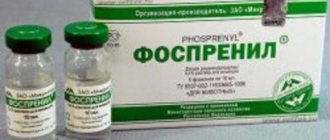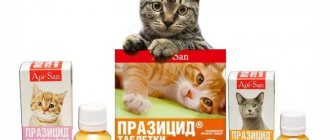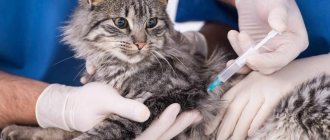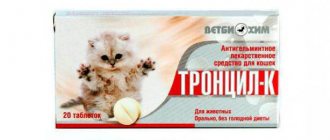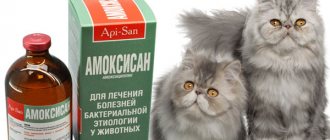What are the dangers of dehydration?
Water is a medium for various chemical reactions in the body; a decrease in fluid levels leads to metabolic disorders.
A decrease in the level of fluid in the body can lead to thickening of the blood, as a result of which the blood circulates more slowly throughout the body, supplying it with oxygen less well and removing toxins, which leads to kidney and heart failure, intoxication and shock.
Important electrolytes such as potassium, sodium and chlorine are dissolved in the liquid. Their imbalance can lead to serious consequences, including neurological disorders.
Decreased fluid intake can lead to severe constipation and difficulty defecating.
Symptoms and treatment of dehydration in a cat at home
Doctors are increasingly faced with the phenomenon of dehydration in cats. Since two-thirds of a cat’s body consists of water, its lack leads to irreversible consequences for the body.
If the amount of fluid entering the body is 10% less than the required amount, it is possible to save the animal, but when this amount reaches 20%, dehydration leads to death.
Why dehydration occurs and how to treat it is described in this article.
How is the disease diagnosed?
If the epithelium is excessively dry, a cat is often diagnosed with dehydration. This can be detected by pulling the animal by the withers. In a healthy individual, it should immediately return to its place. If disease is present, the tubercle remains motionless for some time.
At home, you can perform the following test: open the animal’s mouth slightly and lightly press on the gums behind the upper teeth. If they have acquired a light shade, it persists for more than three seconds without immediately returning to its original state - this indicates illness. Probably, the capillaries fill very slowly because the cat is suffering from exicosis.
In a clinical setting, blood is taken for general and biochemical analysis. Additionally, the animal is examined for the presence of diabetes mellitus and kidney and liver pathologies.
Symptoms
The disease in an animal occurs with symptoms that can accompany various diseases, so it is necessary to show the pet to a doctor.
If an animal suffers from vomiting and diarrhea and does not drink water at all, this is an alarming sign.
The inability to defecate indicates insufficient fluid levels in the body.
If the oral mucosa is light in color, the saliva is viscous and does not excrete well, this indicates the presence of pathologies.
With existing infectious diseases and inflammation, the temperature can not only rise, but also fall. A sharp change in body temperature leads to profuse sweating and, accordingly, loss of large amounts of fluid.
So, let's name the main symptoms of the disease:
- dry skin;
- lethargy of the animal;
- sunken eyes;
- lack of normal appetite;
- constipation or diarrhea;
- arrhythmia;
- body temperature atypical for an individual;
- saliva viscosity;
- light shade of gums.
Treatment
If signs of dehydration are noticed, you should immediately begin procedures to restore water balance.
When the above symptoms (not vomiting) are detected, you can try to forcefully inject the cat with water or an aqueous solution with salt and granulated sugar into the oral cavity.
If vomiting, you can inject a solution of sodium chloride or glucose (10 ml) into the cat’s withers. Additionally, you can administer 1 ml of Gamavit. When purchasing livestock, it is better to learn how to give injections from a veterinarian in advance.
Such manipulations will save the cat from loss of moisture and minerals, and help his body before contacting a doctor. Loss of beneficial components can lead to death, while treatment of the concomitant disease can be done later.
At the clinic, cats are treated through intravenous infusions. The cat is brought into the treatment room and fluid is replenished through droppers with a solution that ensures normal vital functions. If it is not possible to regularly attend procedures with a cat, it is left under the supervision of a specialist in a hospital, where treatment procedures are performed.
Forecast
If you become dehydrated, it is important to take action quickly. When all fluid restoration procedures have been completed, the cat's chances of quickly curing the disease that led to dehydration increase.
If the cause of dehydration is a simple lack of fluid intake, the animal quickly recovers after receiving injections and replenishing moisture in the cells and connective tissues. The speed of recovery depends on the age of the cat, the presence of chronic diseases and the state of immunity.
Every owner needs to know how to treat dehydration in a cat, including at home. This will allow her to live without worries and please others for a long time.
Source: https://VeterinarGid.ru/cats/vet/obezvozhivanie-u-kota-lechenie-v-domashnih-usloviyah.html
Causes of dehydration
The causes of dehydration can be indirectly divided into two categories - a decrease in fluid intake
and
increased fluid loss.
Reduce fluid intake.
Each body needs fluid in certain quantities, which the animal receives not only with water, but also with food. Reducing your cat's water and food intake as a result of illness or other reasons (for example, if you are away and don't give your cat anything to drink or eat) will lead to dehydration.
Increased fluid loss.
In some diseases, fluid loss may occur from the body itself. This most often occurs with vomiting, diarrhea and kidney disease. In renal failure, the kidneys are unable to retain the required amount of fluid and excrete excess fluid in the urine. With vomiting and diarrhea, excess fluid is lost through vomit or loose stools.
Other causes of increased fluid loss include fever, large wounds, burns, or prolonged hypersalivation.
How to spot dehydration
Typically, the level of dehydration is determined by a veterinarian based on a survey of the owner, a general examination of the animal and its tests. The most common way to determine dehydration in animals is a skin turgor test. If the skin on the cat’s withers, pulled upward, slowly returns to its original state, then this is a sign of dehydration, which is measured as a percentage based on the nature of the turgor. This percentage indicates the amount of fluid in the body that the cat lacks. The maximum amount of dehydration that a living animal can have is 15%. Any dehydration of a greater percentage is incompatible with life.
Dehydration 5%.
Pets that are 5 percent dehydrated have little loss of skin elasticity. The skin will return to its normal position, but it will do so a little slower than usual.
With dehydration 6-9%
there is a noticeable delay in the skin returning to its normal appearance. The gums may also be dry and the eyeballs may appear slightly sunken.
In pets with 10-12% dehydration
When pulled back, the skin will remain in a “tent” position. The eyes are significantly sunken, the heart rate increases, and a weak pulse is observed.
Cats with 12-15% dehydration
are in a life-threatening situation. A patient with this type of dehydration is unable to stand and may be in shock. If intensive treatment is not carried out in time, the animal may die.
Dehydration in a cat: what to do at home: symptoms
Increased loss of water and beneficial microelements in the body is called dehydration. Unfortunately, this also often happens with our smaller brothers, in particular cats.
Normal water content in a cat's body
60% of a healthy cat's body is water!
The percentage of water contained in a cat's body is approximately sixty percent .
A drop in water level of five percent or more is a sign of dehydration, a serious reason to consult a veterinarian. Any delay can end disastrously for your pet.
Three types of dehydration
There are three types of dehydration:
- weak - up to five percent;
- moderate - about five or ten;
- heavy - from ten and more.
Mild dehydration is almost asymptomatic. A slight weakness of the animal looks like simple fatigue after active games or hunting. Therefore, the onset of dehydration is almost impossible to notice.
Sticky saliva indicates moderate dehydration.
During a moderate course, the most striking and characteristic sign is the stickiness of saliva.
In severe cases , the cat is weak, constantly lies down, does not make contact, and refuses food and water. The doctor should determine the reasons. Finding out on your own will only delay time and aggravate the existing disease.
Symptoms of dehydration (tests)
Standard dehydration test.
Home tests for skin elasticity and capillary refill time .
The elasticity of the skin is checked by pulling the skin at the nape of the neck. Normally, the skin should immediately return to its original position. A sick animal remains in a drawn-out state for some time. The time it takes for the skin to settle back to its original position indicates the severity of dehydration.
Capillary refill rate
The rate of capillary refill is determined by retracting the upper lip and pressing on the gum. Using a stopwatch, you can measure the time it takes for the area of pressure to lose its whitish mark and return to its original appearance.
Normally, the return process takes up to two seconds. This test is performed to determine blood circulation, the presence of heart failure or shock.
Visual signs of dehydration in a cat
It is possible to determine the presence of dehydration by some visible signs.
The cat is lethargic, looks tired, moves its paws with difficulty. The gums feel dry and sticky to the touch, the eyes are sunken.
Cannot go to the litter box for a long time, has difficulty emptying, and is constipated. If you listen, you can hear a rapid heartbeat.
Causes
If a cat stays outside for a long time and lacks fresh water, it can suffer from heatstroke and dehydration.
The causes of dehydration can be quite varied.
- Diseases that are characterized by such manifestations as diarrhea and vomiting: diseases of the digestive system, intoxication, infection with worms.
- Pathologies in the animal’s body that cause frequent urination - endocrine disorders: diabetes mellitus, kidney failure.
- Staying outside for a long time in extreme heat or in a stuffy, enclosed room is a heat stroke .
- Inability to access fresh, clean water .
- Shock and stress conditions : recent operations, painful medical events, moving in a confined space.
- Pathologies or injuries accompanied by heavy blood loss.
- Feverish conditions.
- In addition, any painful condition manifested by an increase in body temperature - injuries, inflammatory processes - . The pet’s body is depressed in such cases and she refuses to take food and drink, which aggravates the course of the disease and general condition.
Treatment of dehydration
The principle of treating dehydration at home is to immediately replenish lost fluid.
Add canned cat juice to the water!
The animal should be placed in a cool, dark room and provided with sufficient water. It is sometimes recommended to supplement the drink with liquid from canned food, flavored water with the smell of meat and the presence of electrolytes.
If the pet refuses to take water on its own, you should force it to drink using a syringe.
Injecting fluid under the skin
Injection of liquid under the skin is also indicated. To do this, take a syringe with a needle and Ringer's solution. The animal's skin is lifted in the area of the withers and the solution is injected. The dose of the administered solution is determined by the veterinarian.
If your pet does not refuse food, it is worth replacing dry and solid food with liquid food. Droppers with glucose solution are indicated for use.
Drug treatment for dehydration in cats
Drug treatment is prescribed by the doctor, based on the results of the examination and the identified pathologies that caused dehydration. You should not hesitate if dangerous symptoms such as diarrhea and vomiting occur. You should contact the clinic immediately.
Prevention
Make sure the water in your cat's bowl is always fresh.
For preventive purposes, it is necessary to control your pet’s access to water.
Frequent outdoor exercise in summer should be provided with a small shelter for the animal. If a cat has chronic diseases or genetic pathologies, you should carefully monitor its condition, changes in mood, behavior, and changes in habits.
The diet must be balanced and contain sufficient fluid. The room where the pet is kept should not be stuffy.
Source: https://mykoshka.ru/obezvozhivanie-u-koshki-chto-delat/
Diagnosis of dehydration
In addition to the general examination, the veterinarian will take blood tests from a cat showing signs of dehydration.
- Hematocrit value (PCV)
. Hematocrit is the percentage of red blood cells (erythrocytes) in the total blood volume. With dehydration, there is not enough fluid in the blood, which leads to an increase in PCV. - Total protein
is the number of large protein molecules in the blood. As with red blood cells, when dehydrated, protein concentration increases due to lack of fluid. A dehydrated cat will have elevated total protein. - A urinalysis
may also help identify dehydration. With dehydration, urine concentration increases. - A complete blood count and blood chemistry
can help determine the animal's overall health, as well as possible underlying causes of dehydration. Unfortunately, these tests do not always diagnose dehydration in a cat and may be normal even in a severely dehydrated animal.
Treatment
Dehydration is managed by introducing additional fluid into the patient's body. Fluids may be given subcutaneously (only if dehydration is mild) or intravenously, and intraosseous administration may also be given in very small animals. Intravenous fluid administration is considered preferable, since rehydration occurs faster and can be used for emergency care. The solutions administered to the animal also contain electrolytes or glucose needed by the body, as well as the main drugs to treat the cause of dehydration. Giving intravenous solutions to a cat is called an “intravenous infusion” and, depending on the general condition of the animal, it can last from a few minutes to several hours.
Recommendations
It is necessary that the domestic cat always has access to drink. If your cat doesn't drink enough water, you can replace dry food with wet food, which contains about 70% moisture, or add water to the food.
In case of some problems, for example, chronic renal failure, regular fluid administration is recommended for cats due to poor kidney function. In this case, the veterinarian may prescribe subcutaneous injections of solutions to the cat in a certain amount at a certain interval.
Some animals drink quite a bit and this will not be a pathology if the pet has regular bowel movements, normal turgor, good general health and moist mucous membranes.
Treatment for dehydration in a cat at home: is it possible to give a cat a saline solution?
60% of a healthy cat's body is water!
The percentage of water contained in a cat's body is approximately sixty percent .
A drop in water level of five percent or more is a sign of dehydration, a serious reason to consult a veterinarian. Any delay can end disastrously for your pet.
Help with animal dehydration
The best option is to contact a veterinarian. He will find out the cause of the pathology, assess its degree and, most likely, administer an intravenous infusion of glucose.
But when it is not possible to contact a specialist, the owner must act independently, quickly and competently. The pet should be moved to a dark and cool place and offered water.
If the cat is very weakened and simply cannot drink, then wet his lips and introduce water at room temperature with a pipette. You can also use a syringe without a needle for this. If there is a large loss of fluid, the victim must be given injections of saline solution with glucose.
It should be injected slowly, carefully rubbing the injection site after removing the needle.
